It's no secret that thanks to its resistance to cleaning agents and moisture resistance, tiles have become one of the most popular finishing materials. Despite the emergence of new rather interesting wall and floor coverings, bathroom tiles firmly hold their leading positions.
Today we will talk about how to choose the right material, how to combine it, which tiles are more suitable for spacious and very small rooms.
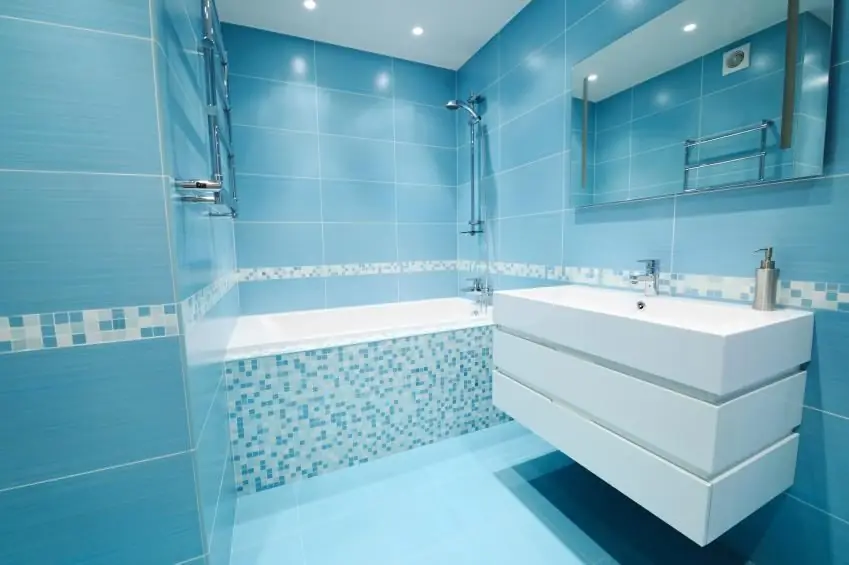
Styling
At the stage of renovation planning, it is necessary to determine the style and design of bathroom tiles. We will present you a photo of the original solutions in this article. Today, the bathroom is most often decorated in accordance with the following styles:
Classic
It never loses its chic, and includes three main directions - English, French and Venetian. Such a tile has a glossy surface, which is aged in white, blue or cream tones. Spectacular finishes are golden and bronze shades.
Mediterranean style
The tile in the bathroom looks elegant in this style (you can see the photo below) thanks to the use of natural colors (sky blue, sand, terracotta, emerald). In this case, interior features are emphasized by decorative elements - mosaics and panels.

Hi-tech
This style is aimed at the maximum convenience of homeowners. Vertical and horizontal surfaces are decorated with silver and white tiles. A tile with decorative inserts will be a great addition.
Modern
To create a luxurious design in this style, bathroom tiles in pastel colors (background) are used and panels are used, mirrors are decorated with mosaics. You can place accents using rich shades.
Layout
Many believe that the layout is a special design technique that has an exclusively decorative function. This is not entirely true. A competent combination of texture, color, tile size will allow you to beat the existing problems of the room: low ceiling, narrow and elongated shape, technological ledges and niches in the walls. Let's consider such situations in more detail.
Low ceiling
In this case, vertical accents come into play, which help to visually increase the height of the room, make it more coherent and harmonious. This layout is used to accentuate one wall. Most often, several thin stripes are combined with one wide one.
High ceiling
For such a room, tiles for horizontalstyling. It can be a single wide line, which will take at least 1/6 of the total height of the room, or several thin horizontal stripes. If the problem of a very high ceiling is exacerbated by the narrow shape of the bathroom, the tiles are laid according to the “dark bottom, light top” principle. An alternative to this option that allows you to save a little, you can consider a combination of tiles on the top and dark wall panels on the bottom.
Narrow elongated room
Tiles in a small bathroom are sometimes selected in such a way as to move the wall, of course, visually. To do this, use a dark tile on the wall, which must be brought closer. This technique is relevant in the case when the room is disproportionately elongated.
Basic principles for choosing tiles: color palette
As a rule, apartments have no windows and a small bathroom. The tile for such a room should not be dark: it will visually reduce the room, create a rather oppressive atmosphere. To give it lightness, use a combination of aquamarine and pink or purple. Freshness and coolness will bring white and aquamarine colors. Warm-colored tiles will make the design of the bathroom more comfortable.
Modern designers often use a combination of tiles of different colors and sizes. Combinations of green with scarlet, sand with purple, orange with blue are considered very stylish.
Tile size
When tiling a bathroom, you will not be able to make the seams completely invisible. In order for the coating to be better perceived visually, it is necessarythink in advance about the parameters of the tile used.
Standard
Tile sizes 20x30 cm are considered standard. Such a coating fits perfectly into medium and large rooms: the frequent arrangement of seams in this case will not be too intrusive.
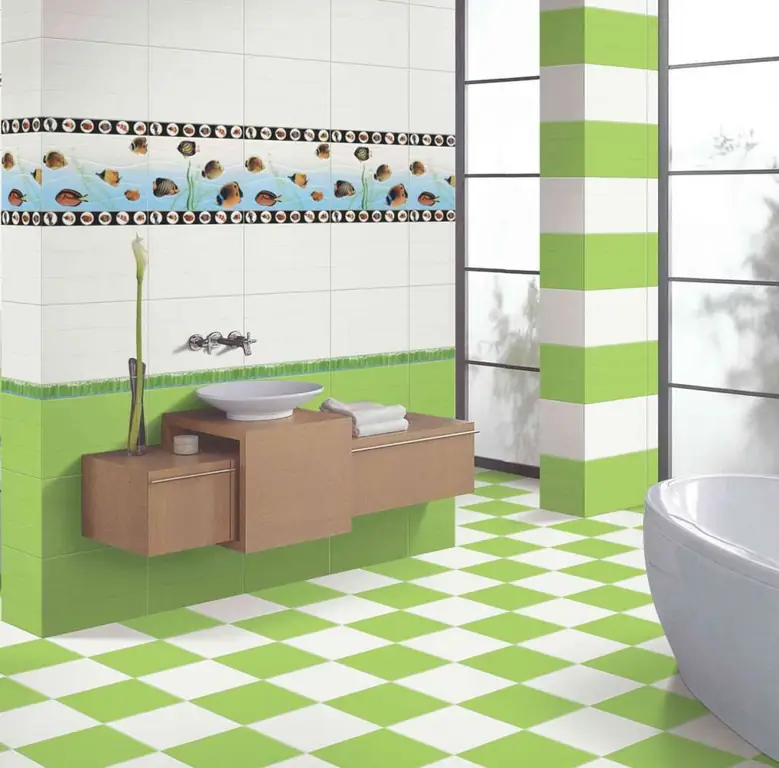
Big tile
Tile (for bathroom) larger than 25x40 cm is considered large. Such tiles are used for finishing floors, and when facing walls, they are used in combination with a small one, as a decorating element.
Mosaic
When researching bathroom design photos in home decor publications, the small size tile is sure to grab your attention. Mosaic has an indisputable advantage - with the help of such material, even very uneven walls can be corrected. The disadvantage of a small tile is the visual reduction of the room. This can be avoided by combining the mosaic with medium-sized tiles.
Cover assignment
It is easy to identify by the pictograms printed on the reverse side of the cover. The image of the “feet” indicates that you have a floor tile with increased strength that does not slip when wet. A "hand" on a dark background means it is a brittle material that should be used for cladding vertical surfaces. "Snowflake" indicates the frost resistance of the cladding.
To choose a bathroom floor tile, choose a material that has I-III strength class. More wear-resistant tiles (IV-V classes) are more suitable for hallways, corridors and kitchens.
Material thickness
Walls and other vertical surfaces require tiles 6 to 9 mm thick. For the floor, a coating with a thickness of 9 to 12 mm is suitable. This indicator is indicated on the tile in the form of an icon with a number.
Moisture resistant
This is one of the things you should pay attention to when choosing bathroom tiles. Depending on the susceptibility of the material to the effects of water, experts distinguish 8 groups. For bathroom floors and walls, use tiles with a finely porous structure, classified by manufacturers in groups 1-3.
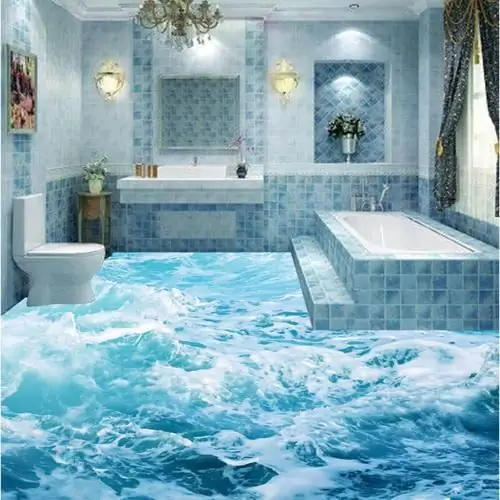
Resistant to aggressive environments
Quality tile is not afraid of fungus and mold. However, it is very difficult to keep the room clean without using detergents. For the bathroom, choose tile marked "AA", indicating the use of household chemicals.
Texture, tile pattern, which are always relevant
Thanks to digital printing technology, tiles imitating natural materials such as wood, stone, marble are widely used today. In addition to the perfect identity of the drawing, the specialists managed to create a very close texture. Such a bathroom tile, in addition to visual appeal, has another advantage - the cost, which is much lower than the price of natural materials, such as marble or onyx.
Stone-like tiles have practically no style restrictions. In a classic interior, marble stains will create a beautifuland a calm backdrop for expensive plumbing or emphasize minimalism in design.
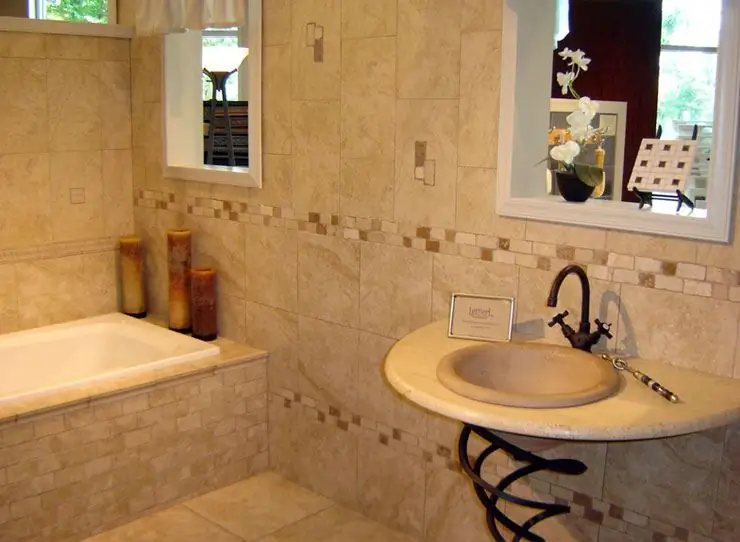
Quality stone-like tiles can be purchased in the collections of Atlas Concorde, Peronda, Kerama Marazzi.
Today, not only imitations of expensive materials are popular, but also tiles with the texture and color of sandstone, slate, shell rock. Effects such as aging and brushing make wood-look tiles look realistic. This material is appropriate when arranging a bathroom in a loft style.
Patchwork is a special technology of sewing from multi-colored shreds. "Patches" of ceramic tiles create a magnificent single canvas. Such tiles are used in flooring or as an accent. Ready patchwork collections are produced by Serenissima CIR (Biarritz series), Cerama Floranese (Inside collection), Del Conca (Amarcord), ABK (Docks).
Does the type of house matter?
Yes, and essential. The thing is that in different types of houses, apartments differ not only in area, but also in layout. When choosing a tile design in the bathroom (we posted a photo in this article), it is important to consider the type of bathroom - separate or combined, the area of \u200b\u200bthe room and the height of the ceilings.
Khrushchevka
In these houses, the bathroom is combined (the bathroom is combined with the toilet). At the same time, its area often does not exceed 3 m². Such characteristics limit the design of horizontal and vertical surfaces to only light colors. Choose a medium sized tile. To increase the height of the ceilings, designers recommend using the following technique:the colors of the bottom and top of the wall are combined. Vertical surfaces should be divided into two zones. The tile should be darker at the bottom.
Panel house
In the apartments of panel houses, bathrooms are separate. This allows you to use tiles in the bathroom of any size and color combination. In panel houses, the walls are tiled with tiles of the same size, but with different designs.
Private house
The plan of a private house most often involves the original and spacious layout of the bathroom. In such a room, you can safely use a large tile: it will not change the visual perception of the room.

Aesthetic features
From an aesthetic point of view, the main dilemma when choosing a tile for the bathroom is the balanced finish of the walls and floor. Designers advise using two options:
- design in a single color scheme;
- use wall and floor decoration in contrasting colors.
The first option is considered traditional. In this case, the interior is very harmonious, creates a feeling of a complete composition. When using the second method, it must be borne in mind that contrasting notes should be traced throughout the interior, including furniture.
How to reduce costs when choosing a tile?
This question, no doubt, excites buyers. This can be done by combining inexpensive bathroom tiles with designer collections.
Neutral background
When purchasing an inexpensive plain tile, you need to makeemphasis on color grout. One important point should be clarified - inexpensive does not mean low-quality at all. Many well-known manufacturers have budget collections in their assortment.
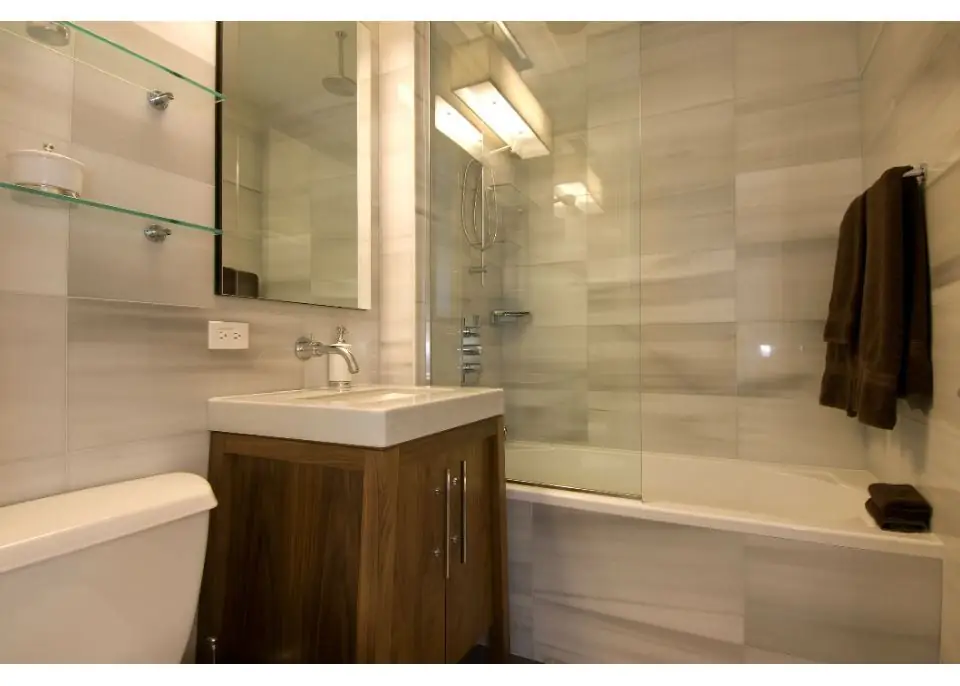
Change tile orientation
Rectangular tiles, which have a chamfer ("boar"), usually fit horizontally, by changing the installation, you can visually enlarge the room. Do not buy classic thick crosses for the "boar", they reduce the cost of the appearance of the tile. Separators should be no more than 0.5 mm. For a small tile bathroom, it is better to purchase medium-sized tiles. Cutting it will leave less waste.
Shape of tiles
Another way to save money is brick-shaped tiles. It is laid without displacement in such a way that there are no trimmings less than 5 cm.
Elite meter
You can create an "expensive" design using quite a bit of elite tiles, which are used locally in wall decoration, for example, near a mirror. If the designer tile you have chosen does not match the inexpensive backdrop due to a different shape (hexagonal, for example), use paint.
How to choose grout for tiles?
Unfortunately, a well-chosen and well-laid tile does not guarantee a winning interior design if the filler is chosen incorrectly. Before choosing a grout for tiles in the bathroom, you need to decide what kind of base they have. Today in specialized stores there are three types of grouts:
Cement
These are dry cement mixes. They are used to fill joints with a thickness of not more than 20 mm.
Furan
Such compositions are made on the basis of furan resin. They are used only in industrial premises.
Epoxy
Resin-based grouts (two-component). They cost an order of magnitude more expensive, but at the same time they are distinguished by durability and strength.
To finish the bathroom, you should choose grouts, which include additives that prevent the growth of mold and the formation of fungus. Designers advise choosing a grout in the closest possible tone to the color of the tile. This will give integrity to the closed room. At the same time, contrasting combinations look very original. But this option can only be used if the tile is laid perfectly, otherwise it will only emphasize the existing flaws.
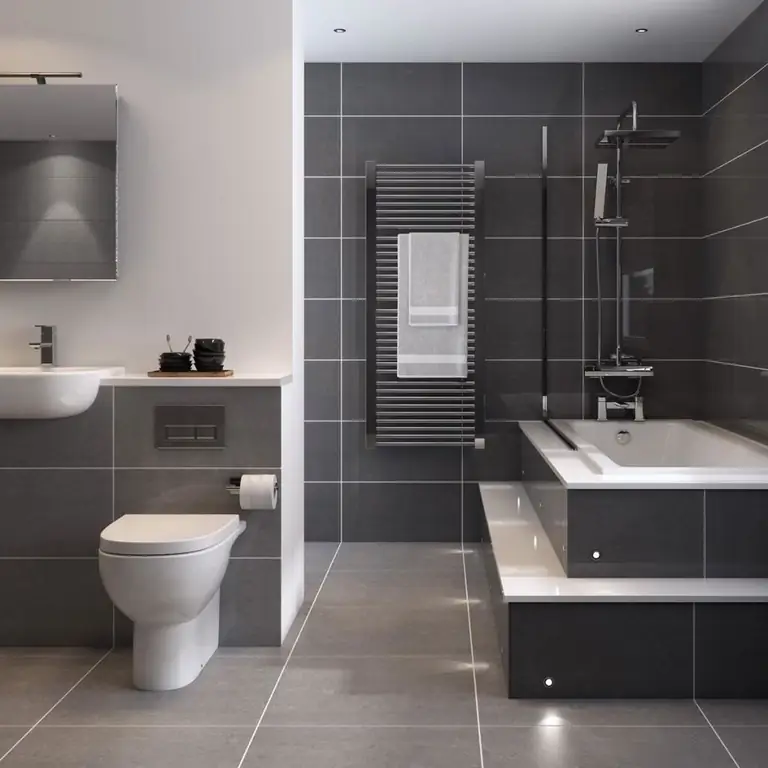
We told you about the rules for choosing tiles for the bathroom. The photos that are posted in the article will surely help you make your choice. And finally, one more piece of advice from experts - do not buy the rest of the collections. As a rule, they are sold at a big discount, but it is likely that some items will not be enough in the collection. It will be a shame if 1-2 tiles are not enough, which cannot be purchased in addition.






